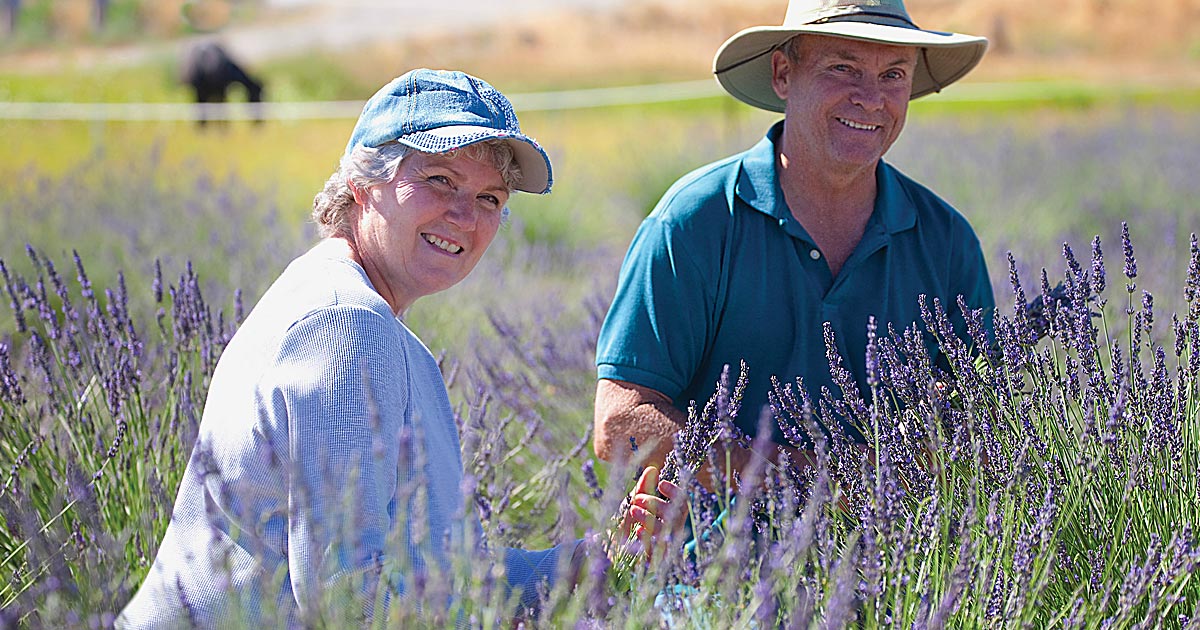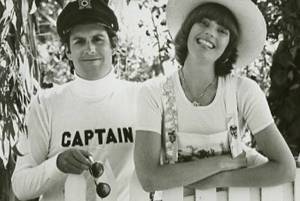By DIANNA TROYER
With retirement pending, three Idaho couples pondered ways to luxuriate in their newfound time. What could they do to exercise, socialize, and even specialize in revitalizing others’ lives? They began raising lavender, an epic hardy shrub prized for its culinary and medicinal uses.
Tending to their fields, lavender farmers slip into soothing seasonal rhythms, likening their tasks to aromatherapy sessions. In spring, they cherish the bountiful blossoms. Throughout summer they weed by hand. During late summer, they cut and bundle their bounty. In autumn, they prune the lavender into mounds, anticipating future robust growth.
Lavender is becoming an increasingly popular crop on small acreage. There are 45 species to choose from with more than 450 varieties. A pest-resistant perennial shrub, it requires minimal watering and fertilization. It thrives in full sun and well-drained soil. Each plant lives about 10 years.
For centuries worldwide, lavender has been prized for cooking, floral arrangements, and as an ingredient in health and beauty products. Studies suggest lavender benefits those with depression, insomnia and anxiety, and that its oil has antiseptic and anti-inflammatory properties. After harvest, it preserves naturally, stores well, and can be sold year-round. The aroma in a dried bouquet can be refreshed by spritzing it with water mixed with a little rubbing alcohol.
“Every spring, we never take for granted how beautiful the first blossoms look and smell,” said Carla Ketchum, 67, who started Ketchum Hollow Lavender with her husband, Chris, at their home near Rupert in southeastern Idaho in 2015. “God put lavender in my life at the perfect time, when I was diagnosed with breast cancer and needed its calming scent.”
Meanwhile in southwestern Idaho near Eagle, Red Chair Lavender owners Bill and Wendy Southerland host a popular festival every July. Founded in 2011, they produce 6,000 plants of 32 varieties on a little more than two acres.
“About two-thirds of our crop is distilled into oil,” Bill said. “One of our markets is assisted living facilities, where it’s used for those in memory care. Using essential oils, especially like lavender, is becoming mainstream because it helps reduce some residents’ agitation levels without resorting to medication. Staff members say they like being around it, too.”
Bill, 73, said he noticed the trend with his 25 years of experience in developing small-scale, personalized assisted living facilities nationwide.
Eastern Idahoans Matt and Lori Isom became instant lavender farmers when they bought imported French shrubs from a retiring couple and transplanted them next to their home west of Idaho Falls in 2018.
Their agri-tourism enterprise, Idaho Lavender Farm, has become a destination for lavender lovers and also an outdoor studio for portrait photographers. A small home they own across the road is listed on Airbnb as a summer destination to their lavender fields.
“We decided to do a u-pick farm because we’re both still working and can’t be here all the time,” Lori said. “We trust people to pick it and pay on the honor system.”
Ketchum Hollow
Before launching their half-acre, u-pick lavender farm, Chris Ketchum researched what crops would thrive in their sandy soil and be suitable to their climate.
“We realized lavender would be ideal, and it also happens to be one of Carla’s favorite plants and aromas,” Chris said. “We wanted to do something we would enjoy that would also put some beauty in the world.”
It took them six weeks to plant 1,200 seedlings. They installed a dripline, weeded by hand, and wondered about their first harvest.
“We had 80 bundles,” Carla said. “By our third and fourth years, we were cutting about 3,700 bundles, with each bundle having 80 to 90 stems. We have regular customers who return yearly to pick their own or buy bundles.”
During their three-week harvest in late July and August, the average yield from 700 plants is about 2,000 bundles.
They chose three varieties. Grosso is prized for its scent. Hidcote Giant grows about 30 inches tall and is popular for floral arrangements. Munsted with its floral and sweet flavor is most often used in cooking.
Carla adds lavender to pancake mix, shortbread cookies, lemonade, and honey. She also puts it in soups and uses it in a savory meat rub. Outside the kitchen, she makes lavender wreaths, wands, sachets, bouquets, a powdered laundry booster, hand sanitizer, bubbling bath salts, and a room spritzer.
“Studies have shown lavender is calming and helps alleviate depression and insomnia,” she said. “It’s even helped some people with PTSD.”
In hindsight, Carla said lavender was serendipitous for her health. Diagnosed with stage 2 breast cancer in 2015, she relied on its scent throughout her treatment. She kept a sachet in her car and purse.
“Before every appointment, I inhaled the aroma and it calmed me,” she said. “My daughter made me a cream with lavender oil that I used during 33 radiation treatments, and I never burned. I give credit to God and medical and natural doctors for healing me.”
Red Chair Lavender
Visitors at Red Chair Lavender often ask for advice about starting a lavender farm.
“It’s a crop that can be lucrative on a small piece of land, but you have to make a plan of how you’ll market it,” Bill Southerland said. “For us, probably 60 percent of our annual income comes from our festival. You also need to do research to see whether local planning and zoning regulations will impact your farm. ”
Every July, the Southerlands host their Lavender Harvest Festival with lavender distillation demonstrations, crafts, food and beverages, u-pick options, musicians, and artists.
The Southerlands established their farm after going to a lavender festival outside of Pendleton, Oregon, while visiting their daughter and son-in-law over a weekend.
“We saw how happy it made people at the festival, so we wanted to create that at our farm,” said Wendy, 66. “We realized we could grow lavender on about two acres that had previously been used to grow hay.”
They ship fresh and dried bunches nationwide for a variety of events including weddings and bridal and baby showers.
“It’s been a very rewarding and happy journey for us and for countless others who have visited the farm,” Wendy said.
Idaho Lavender Farm
As if a magical fragrant lavender wand had been waved to grant their wish, Matt and Lori Isom became instant lavender farmers—but with an intimidating catch.
They would have to transplant 1,200 lavender shrubs to their 4-acre field adjacent to their home about five miles west of Idaho Falls. Undaunted, the Isoms bought the plants from Teton View Lavender Farm in St. Anthony in 2017 when owners Tom and Linda Howell retired.
“We waited until the spring of 2018 to transplant them all and install a dripline,” Matt said.
A retired farmer, he tackled the task with enthusiasm. Naming their venture Idaho Lavender Farm, the Isoms have nine thriving varieties of culinary and floral lavender that the Howells imported from France. Lori launched a Facebook page for their u-pick farm.
“I’ve always loved lavender,” Lori said.
Matt, 63, sold his farm in 2017 and became a general contractor for MDI Construction, erecting metal buildings and other structures for farmers. Lori, 60, works in public affairs at the Idaho National Laboratory.
One of their varieties, Grosso, is prized for its vigorous growth.
“Each plant produces about 10 to 20 bundles with 50 stems in each bundle,” Lori said. “It’s fairly easy to propagate by placing stems in the ground and watering lightly for about two weeks.”
Families often buy bundles or blossoms for weddings, graduations and other celebrations.
The Isoms learned about raising lavender and its many uses after Matt retired from farming, and they downsized to 7 acres purchased from his uncle.
“We researched crops to grow on small acreage,” Matt said.
While visiting their son at Whidbey Island in Washington, the Isoms toured several lavender farms and joined a lavender association. Returning home, they began researching Idaho lavender farms and found the Howells.
The Isoms grow organic lavender because herbicides and pesticides stunt a plant’s production and shorten its lifespan.
“Matt is out there every morning and evening for about two hours, pulling weeds by hand,” Lori said. “We’re fortunate to have neighboring farmers who don’t do aerial applications of herbicides and pesticides on their potato and grain fields near us.”
During summer, their field is vibrant with a soft buzzing as bees pollinate flowers and gather pollen.
“Bees and butterflies love our lavender, so we don’t want them to be harmed by chemicals,” Lori said. “It’s especially important to me to protect pollinators, being a granddaughter of the founder of Cox’s Honey in Shelley.”
To demonstrate one of lavender’s popular uses, Lori has hosted $25 soap-making workshops during summer on weekends.
“Everyone would leave smiling, with at least two bars of soap, lavender sachet, and a lavender bundle,” Lori said. “We’ve distilled oil, too, and made some lotion.”
After retiring, the Isoms plan to develop local markets for their fragrant crop, selling bundles to florists and buds to chefs.
“Growing lavender will keep us young,” Lori said. ISI










